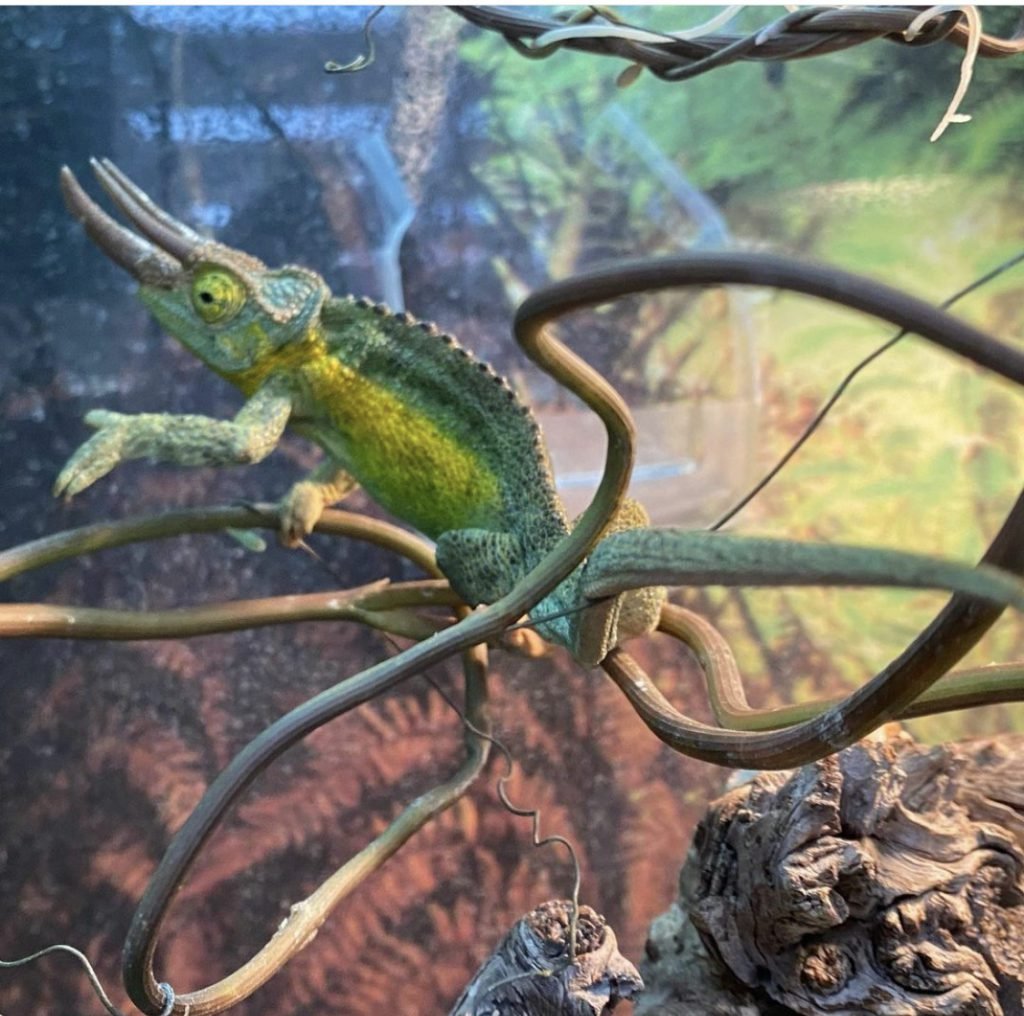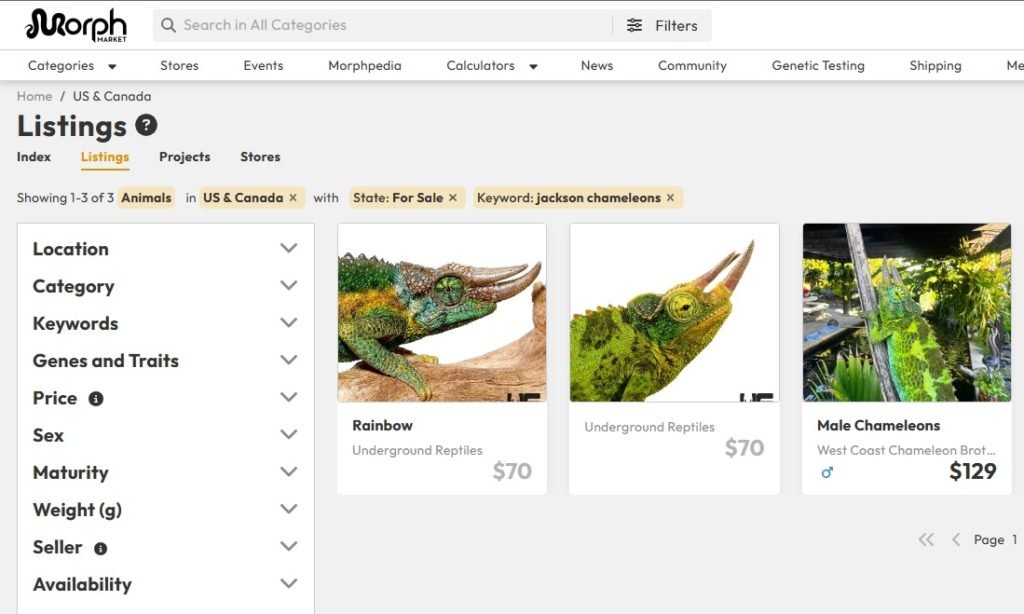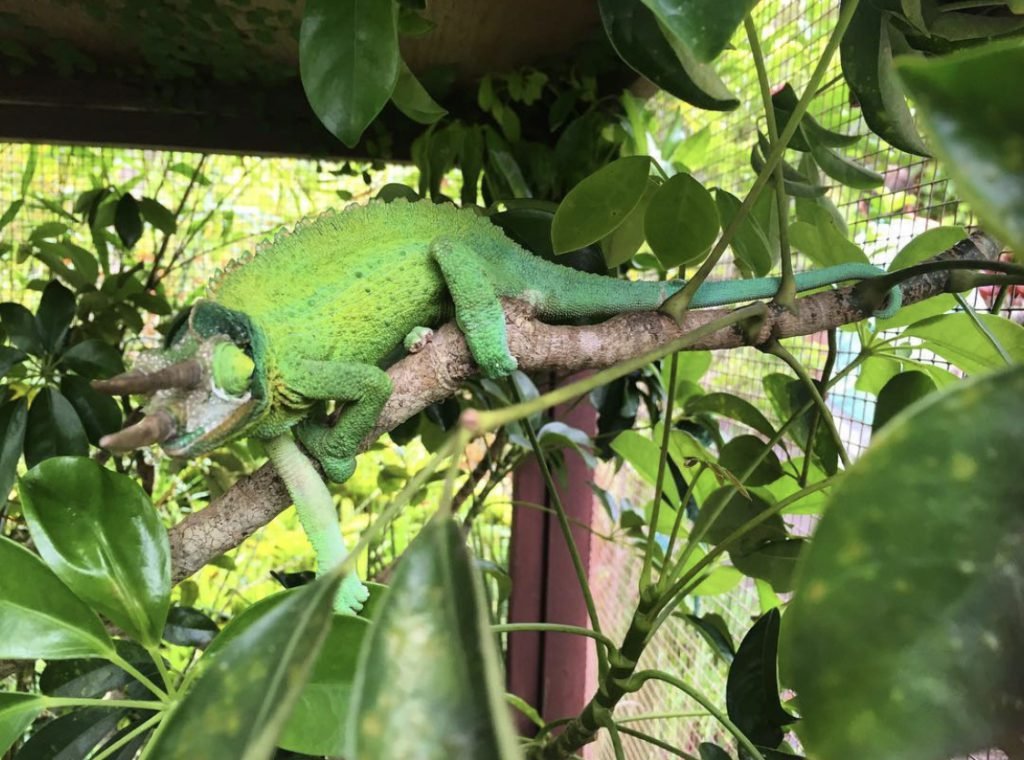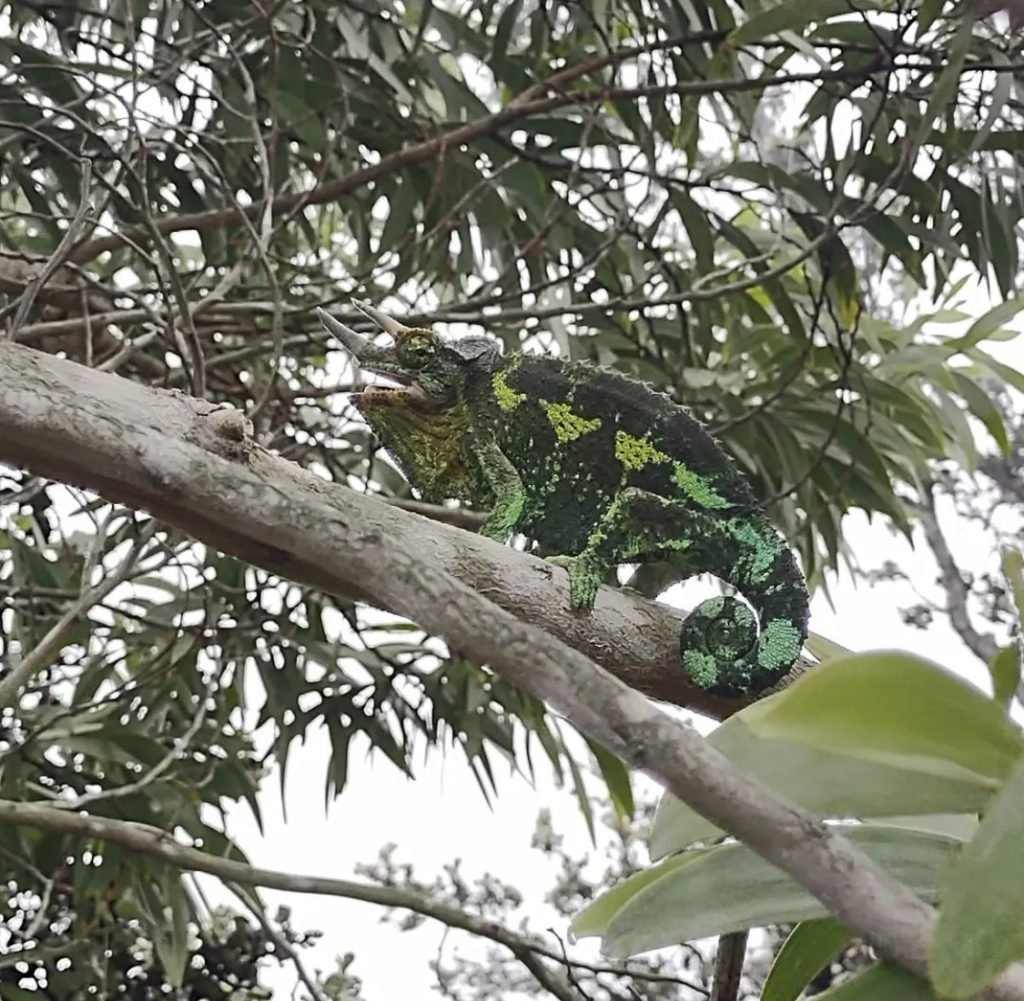Jackson Chameleons are fascinating creatures that captivate the imagination of reptile enthusiasts and casual observers alike. These arboreal reptiles are known for their unique features, remarkable color-changing abilities, and distinctive appearance. In this post, we’ll take an in-depth look at the Jackson Chameleon, exploring its natural habitat, life span, physical characteristics, and more.
Jackson Chameleons Background Information
The Jackson Chameleon lives in Kenya and Tanzania’s high-altitude woodlands at 4,000–9,000 feet. These arboreal reptiles are well adapted to their forest habitat, with long, prehensile tails that they use to grasp branches and climb trees. They are also known for their distinctive appearance, including their large, bulbous heads and protuberant eyes that move independently.

Jackson Chameleons Life Span
The typical life span of a Jackson Chameleon is around 5 to 8 years in the wild. However, they can live up to 10 years in captivity with proper care and nutrition. Some factors that may influence the lifespan of them include their diet and habitat conditions. A diet rich in nutrients and varied in terms of food types and feeding frequency can help to ensure that these reptiles stay healthy and active throughout their lives.
Price of Jackson Chameleons
Average Cost of Jackson Chameleons
The average cost of a Jackson chameleon varies depending on several factors, such as age, gender, size, and overall health. Generally, juvenile Jackson chameleons can cost anywhere from $50 to $150, while adult chameleons can cost up to $500.
Factors that Influence Pricing
Several factors can influence the pricing of Jackson chameleons. The rarity of the color morph or pattern, the age and gender of the chameleon, the health of the chameleon, and the reputation of the breeder or seller can all affect the price.
Hidden Costs to Consider when Purchasing a Jackson Chameleon
When purchasing a Jackson chameleon, one must consider the hidden costs of owning one. These costs include setting up an appropriate habitat, feeding and supplement, and veterinary expenses. It’s important to factor in these costs before purchasing to ensure you are fully prepared to provide the best care for your new pet.

Jackson Chameleon for Sale
Popular Sources for Purchasing Jackson Chameleons
If you’re looking to purchase a Jackson chameleon, there are various sources. One popular option is to buy from a breeder, who will likely have a more fantastic selection of chameleons with a known lineage. Local pet stores may also carry Jackson chameleons, but their choice may be limited. Online retailers and classified ads can also be a good option, but be sure to research and verify the seller’s reputation before making a purchase.
Factors to Consider when Selecting a Pet Jackson Chameleon
There are several things to consider while opting for a Jackson chameleon as a pet. You must pick a chameleon that is well-cared-for and in good health. Consider the chameleon’s age, sex, temperament, availability of suitable housing, and appropriate food sources. To guarantee proper care, research Jackson’s chameleon demands.
Legal Considerations for Owning a Jackson Chameleon
Before purchasing a Jackson chameleon, it’s fundamental to research any legal considerations in your area. Owning a chameleon may require a permit or license in some states or municipalities. Additionally, importing chameleons from other countries may be prohibited or require additional permissions. Familiarizing yourself with local regulations is essential to comply with the law.
Jackson Chameleons Habitat
Enthralling Environs for the Jackson Chameleons, hailing from the African savannas and forests, have specific requirements regarding their habitat. These enigmatic lizards thrive in warm environments with a temperature range of 70-85°F, a humidity level between 50-70%, and ample exposure to UVB lighting. It’s imperative to recreate a habitat that mimics their natural environment as closely as possible to ensure their well-being.
Crafting a Cozy Castle for Captive Jackson Chameleons
For pet owners, replicating the Jackson Chameleon’s native habitat can be challenging. However, with a few essential modifications, you can create a comfortable and suitable environment for your pet.
Start with a ventilated, climbing, and basking terrarium. To maintain terrarium temperature, place a heat lamp or ceramic heater at one end. Add a UVB lamp for proper UV exposure and good growth and digestion. Finally, mist or humidify the terrarium to maintain humidity.

Jackson Chameleons Care
Jackson Chameleons are fascinating and unique pets that require proper care to thrive. This section will cover the essential aspects of caring for a Jackson Chameleon.
Housing and Enclosure Requirements
Providing a suitable enclosure is crucial for the health and well-being of your Jackson Chameleon. The enclosure should be spacious and include climbing branches, foliage, and hiding spots. A heat source and UVB lighting are also necessary to maintain the optimal temperature and light cycle.
Diet and Feeding Schedule
Jackson Chameleons are insectivores and require a varied diet consisting of gut-loaded crickets, roaches, and other insects. You should also provide a vitamin and mineral supplement to ensure they receive all the necessary nutrients. Maintaining a regular feeding schedule is essential to promote healthy digestion and prevent overfeeding.
Handling and Socialization
Jackson Chameleons are not typically known for their social nature and prefer to be left alone. If you need to handle your pet, it is essential to do so with care and caution to avoid causing stress or injury. Always support their entire body, including their legs and tail, when picking them up.
Health Concerns and Veterinary Care
Regular veterinary check-ups are necessary to ensure your Jackson Chameleon is healthy and detect potential health issues early. Common health concerns include respiratory infections, mouth rot, and parasite infestations. You should also maintain proper hygiene and sanitation in their enclosure to prevent the spread of diseases.
Jackson Chameleons Colors
Colorful Jackson Chameleons have vivid greens and yellows to muted greens and browns. These captivating creatures can rapidly change color to communicate with other chameleons or blend into their surroundings. The color change is a fascinating visual display and plays a crucial role in their survival and communication in the wild.
Technicolor Change Scientists have investigated the Jackson Chameleon’s extraordinary physiological capacity to change color. Hormones control this color shift, which is affected by temperature, light, and mood. Understanding the Jackson Chameleon’s color shift and behavior might increase our admiration for this fascinating species.
Jackson Chameleons are Aggresive?
Tackling Territorial Tendencies
This Chameleons can exhibit aggressive behavior, particularly towards other chameleons or potential mates. This territorial tendency is rooted in their instinct to protect their territory and secure a mate.
Managing Captive Jackson Chameleon Aggression
Aggressive behavior may be stressful for owners, but simple techniques can effectively handle it. Providing sufficient space and a comfortable habitat can help reduce territorial tension. Keeping only one Chameleon per enclosure can also mitigate aggressive behavior.

Jackson Chameleons Characteristics and Behaviors
Understanding the Complexities of Chameleons
Social Interactions and Hunting Methods Jackson In the wild, chameleons typically hunt alone. They grab insects quickly with their sticky tongues. Despite their solitary nature, chameleons can coexist with one another in large groups if they are given adequate territory.
The Pros and Cons of Keeping Jackson Chameleons as Pets
Jackson Chameleons make fascinating pets. Still, their specialized needs and solitary nature make them a challenging species to care for. Potential owners must provide a proper home, a varied diet, and an understanding of their distinctive characteristics. This type of Chameleons can live in captivity and show their owners the interesting beauty with adequate care.
Fun Facts: Discovering the Quirks of Jackson Chameleons
Interesting Insights into Jackson Chameleons
- Frederick John Jackson, a British herpetologist from the late 19th century, is credited with naming the Jackson chameleon.
- Chameleons can communicate and blend in by changing color.
- Unlike other species of chameleons, Jackson Chameleons cannot rotate their eyes independently.
- They have a unique “Y” shaped casque on their heads that serves as a visual indicator of their health and well-being.
In conclusion, the Jackson Chameleon is a captivating species with unique characteristics and behaviors that set them apart from other chameleons. There is much to learn about this fascinating species, from their natural habitat to their aggressive tendencies and diet to their distinctive color patterns.

